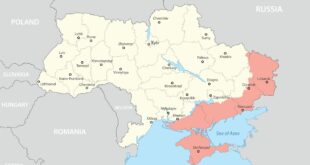Today’s conventional wisdom that economic nationalism and zero-sum strategic competition can coexist with ample international cooperation on existential global issues is an illusion
Editor’s Note: The Red Cell series is published in collaboration with the Stimson Center. Drawing upon the legacy of the CIA’s Red Cell—established following the September 11 attacks to avoid similar analytic failures in the future—the project works to challenge assumptions, misperceptions, and groupthink with a view to encouraging alternative approaches to America’s foreign and national security policy challenges. For more information about the Stimson Center’s Red Cell Project, see here.
Red Cell
Looking back from 2050, historians may view the zero-sum rivalry among the United States, China, and Russia as a posthumous chapter in historian Barbara Tuchman’s book The March of Folly. Would the world have been better prepared for the pandemic of 2033 if global public health cooperation had not been obstructed by geopolitical competition? Would the Great Depression of 2031 have happened if great power blocs had not fractured the regulation of global trade and finance?
Would the chain of failing states across the belt of Africa and the massive surge of economic refugees from the continent to Europe have happened in the late 2020s and early 2030s? Similarly, would the U.S. immigration wave have surged if states like Haiti and Nicaragua had not been overwhelmed by droughts and floods caused by climate change? Would parts of Miami and Manhattan not be underwater in 2050 if there had been ample cooperation to reach the Paris Climate Accord goals?
It is unclear whether decision-makers in major powers grasp the costs—plus the human and planetary consequences—of zero-sum, great power competition. This counterfactual narrative may seem like a dystopian sci-fi novel, but it captures the possible futures resulting from the current dynamic of a split-screen world. Major powers are making choices—allocating resources to arms races, fostering strategic rivalries that distort the global economy, and promoting inward-looking nationalisms. Such a trajectory renders cooperation on existential global challenges increasingly elusive.
The Director of National Intelligence illuminated the precarity of the human predicament in the forward of the intelligence community’s Annual Threat Assessment:
The United States faces an increasingly fragile global order strained by accelerating strategic competition among major powers, more intense and unpredictable transnational challenges, and multiple regional conflicts with far-reaching implications…Regional and localized conflicts and instability…will demand U.S. attention.
The reality is that the zero-sum great power competition is eclipsing efforts to meet global challenges. Today’s conventional wisdom is that economic nationalism and zero-sum strategic competition can coexist with ample international cooperation on existential global issues. This is an illusion, however. The data and trends suggest that global cooperation is required now more than ever to redress pressing problems vital to sustainable economic growth, mitigating the impacts of climate change, coping with pandemics, reforming outmoded institutions, and finding a stable global equilibrium. In addition to exacerbating climate change, the likely consequences of this rivalry are a growing North-South inequality divide, generating hopelessness and fostering poverty as well as religious extremism, terrorism, and larger refugee flows.
Awareness of such causality seems absent in the growing tit-for-tat of the U.S.-China-Russia great power competition. Contrast the present world situation to the Cold War’s U.S.-Soviet bipolar stability, albeit a fragile one. The historic uncertainties of a zeitgeist of zero-sum U.S. competition with China, as well as Russia being canceled from Europe entirely, leave the world in uncharted waters. Increasingly, these times resemble the eroding of the international order that characterized the 1930s.
In the current backlash to globalization’s excesses and great power rivalry, the factors that enabled a fragile peace—an absence of a post–World War II major interstate war—are eroding. It is useful to consider what components created the conditions for unprecedented prosperity and peace among major powers in the post–World War II period. There were several mutually reinforcing factors: a relatively open economic and rules-based system; global trade and financial institutions that helped manage risks and facilitated growth and prosperity; a U.S. security umbrella over Western Europe and East Asia; and a stable if sometimes precarious, nuclear bipolar balance of power. And, not least, as the 1962 Cuban Missile Crisis illustrated, fearful U.S. and Soviet leaders, President John F. Kennedy and Premier Nikita Khrushchev were terrified of igniting a nuclear holocaust. Consequently, they were willing to compromise to achieve a peaceful end to multiple crises. Today, many of those factors seem to be non-existent, and level-headedness in decision-making has become a scarcity.
Correcting the Record
Globalization lifted one billion people out of poverty and saw six decades of unprecedented growth, a great boon to humanity. According to the World Bank, between 1988 and 2013, “average income grew by 24 percent globally, the global poverty headcount ratio declined from 35% to 10.7%, and the income of the bottom 40 percent of the world population increased by close to 50 percent.” Lately, the new version of globalization is rewiring trade patterns into fragmenting clusters, threatening to undo the earlier progress. The International Monetary Fund’s (IMF) deputy managing director recently warned that the current “geoeconomic fragmentation” could reduce global GDP by up to 7 percent over time. As always, the poorest countries are the most vulnerable to a global economic downturn.
A global middle class, numbering four billion, started to rise with rapid globalization, which continues in prosperous middle-income countries, especially in Asia. The reverse is now happening in poorer states. In 2022, the number of people living in extreme poverty increased by 23 million compared to 2019. Global poverty reduction began to slow in 2015, along with decreasing economic growth in poor countries.
Africa, for example, saw spectacular per capita GDP growth between the mid-1990s and mid-2010s. Debt ballooned with the pandemic’s increased health costs, becoming a major impediment to countries’ growth today. According to the World Bank, twenty-one African states are facing debt distress or the risk of it. As a matter of fact, the continent’s public debt has nearly tripled since 2010 to $656 billion, with annual servicing of the debt amounting to 22.5 percent of the continent’s GDP.
In a more contested world, with globalization fragmenting, the number of conflicts has grown. After decreasing since the end of the Cold War, the number of interstate wars began to increase again after 2014. More than fifty interstate conflicts have been recorded each year for the past eight years. Moreover, civil or internal conflicts such as those in Libya and Sudan have become “internationalized,” meaning that one or more third-party governments have intervened, contributing or deploying combat personnel to help one side or another. Of the fifty-five state-based conflicts today, twenty-two are internationalized civil conflicts. This contrasts with the situation in 2002 when only four civil conflicts were internationalized. Absent an effort being made to stop these wars, poverty and associated misery will only grow. According to onemodeling exercise by the University of Denver’s Pardee Center, ongoing conflicts keep “148.2 million (range: 50.7 to 186.0 million) people living in extreme poverty (<$1.90 per day)…”
Increasing U.S. and Western trade and tech nationalism are ceding the ground to China, whose trade is expanding despite Beijing’s often exploitive practices. Moreover, China has been a top provider of economic development assistance to emerging markets and now trades more with the Global South than with the United States, EU, and Japan combined.
Irreversible Climate Change
Many scientists believe that global warming will temporarily rise above the desired limit of 1.5°C later in the decade, risking a “domino effect” of irreversible changes in ecological systems that further compound warming. On the world’s current course, temperatures will likely rise to 2.9C above preindustrial levels, according to the latest UN Emissions Gap report.
Even if states meet their goals, there is only a 14 percent chance of keeping the temperature rise to 1.5°C, according to the report. The G7 has made progress on reducing emissions and recently called for phasing out coal from power generation during the “first half of the 2030s.” Still, scientists have charged that the G7 needs to do far more, including overall reductions in carbon emissions. The current G7 target of 40–42 percent by 2030 is unlikely to keep the world within the UN Paris agreed 1.5°C global warming limit. A temperature rise higher than 2.0°C would make the shutdown of the Gulf Stream a possibility, irrevocably changing weather patterns in North America and Europe. According to some scientists, the Gulf Stream is already dangerously weakening.
The richest 10 percent of the world’s population accounted for nearly half of emissions in 2021, while the poorest 50 percent contributed only 12 percent of total emissions. It comes as no surprise that historical emissions are even more unbalanced. The consulting firm McKinsey estimates that “the world faces a $41 trillion mitigation investment gap until 2030, with emerging markets facing a higher gap as a share of their GDP. In addition, an adaptation financing gap of $600 billion is required annually to 2050, which is 10–18 times greater than current flows.”
The Myopia of Competition
Historically, international systems tend to work when the major powers are invested in them: the Imperial Chinese tributary system, the Peace of Westphalia, the Concert of Vienna, and the post–World War II liberal order. As major powers started to pursue various competing visions of order, the post–World War II system frayed with growing nationalism, undermining global institutions such as the UN Security Council (UNSC) and World Trade Organization and making cooperation more difficult on any number of fronts—from arms control to maritime and space issues. Festering legacy conflicts from the Balkans, Korea, and Taiwan to full-blown ones in Ukraine can be triggers for a major East-West war.
 Geostrategic Media Political Commentary, Analysis, Security, Defense
Geostrategic Media Political Commentary, Analysis, Security, Defense





